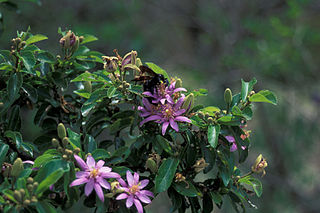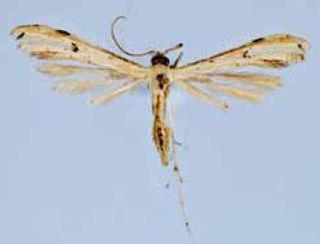
The University of Copenhagen Botanical Garden, usually referred to simply as Copenhagen Botanical Garden, is a botanical garden located in the centre of Copenhagen, Denmark. It covers an area of 10 hectares and is particularly noted for its extensive complex of historical glasshouses dating from 1874.

Grewia is a large flowering plant genus in the mallow family Malvaceae, in the expanded sense as proposed by the Angiosperm Phylogeny Group. Formerly, Grewia was placed in either the family Tiliaceae or the Sparrmanniaceae. However, these were both not monophyletic with respect to other Malvales - as already indicated by the uncertainties surrounding placement of Grewia and similar genera - and have thus been merged into the Malvaceae. Together with the bulk of the former Sparrmanniaceae, Grewia is in the subfamily Grewioideae and therein the tribe Grewieae, of which it is the type genus.
Dombeya amaniensis is a flowering plant species found only in Tanzania. Formerly placed in the family Sterculiaceae, this artificial assemblage is now included in the Malvaceae by most authors.

Tiliacea citrago, the orange sallow, is a species of moth of the family Noctuidae. It is found in Europe as far east as the Caucasus Mountains and the Urals.

The barred Sallow(Tiliacea aurago) is a moth of the family Noctuidae. It is found in Europe.
Tiliacea is a genus of moths of the family Noctuidae.

Encoelia is a genus of fungi in the family Sclerotiniaceae.

Botryosphaeria is a genus of pathogenic fungi in the family Botryosphaeriaceae. There are 193 species, many of which are important disease-causing agents of various important agricultural crops.

Parmelina is a genus of lichen belonging to the family Parmeliaceae. The genus was circumscribed in 1974 by American lichenologist Mason Hale with Parmelina tiliacea assigned as the type species.

Flemingia is a genus of plants in the family Fabaceae. It is native sub-Saharan Africa, Yemen, tropical Asia, and Australasia. In Asia the species are distributed in Bhutan, Burma, China, India; Indonesia, Laos, Malaysia, Nepal, Pakistan, Papua New Guinea, Philippines, Sri Lanka, Taiwan, Thailand and Vietnam. The genus was erected in 1812.

Rutstroemia is a genus of fungi in the family Rutstroemiaceae. It was circumscribed by Petter Karsten in 1871.

Xestia ochreago is a moth of the family Noctuidae.
Cissus tiliacea is a species of the Cissus genus in the Vitaceae family. It is also incorrectly known as Vitistuberosa.

Hellinsia devriesi is a moth of the family Pterophoridae. It is found on the Galapagos Islands and Guadeloupe.

Adaina ipomoeae is a moth of the family Pterophoridae. It is found in Cuba, Jamaica, Puerto Rico, Guadeloupe, the Dominican Republic, Grenada, and Florida.

Parmelina tiliacea is a species of lichen belonging to the family Parmeliaceae.
Paracephaelis is a genus of flowering plants belonging to the family Rubiaceae.
Sclerococcum serusiauxii is a species of lichenicolous fungus in the family Dactylosporaceae. It was described as a new species in 1993 by Montserrat Boqueras and Paul Diederich. The type was collected in Col de la Pierre St Martin, at an altitude of 1,550 m (5,090 ft). Here, the fungus was growing on the lichen Parmelina pastillifera, which itself was growing on Pinus uncinata. The specific epithet honours Belgian lichenologist Emmanuël Sérusiaux, who collected the type specimen in 1989. S. serusiauxii has also been recorded from Montenegro.












